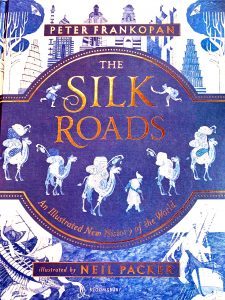by Shadab Zeest Hashmi
 “You start with a scarf…each 90-by-90-centimeter silk carré, printed in Lyon on twill made from thread created by the label’s own silkworms, holds a story. Since 1937, almost 2,500 original artworks have been produced, such as a 19th-century street scene from Ruedu Faubourg St.-Honore, the company’s home since 1880. The flora and fauna of Texas. A beach in Spain’s Basque country” –- this is a fragment from an advertisement article for Hermès in this month’s issue of a luxury magazine. The article is called “The Silk Road.” Does it refer to the “Silk Road” in any way that justifies the title, beyond the allure of legend? No. Does it mention that the first scarves created for this very label, in 1937, were made with raw silk from China? No. Not necessary, not relevant to the target reader. In fact, the less we mention the “East” while trying to sell such luxury designer items, the better, aiming as we are for the rich collector, the global consumer of fashion (whether belonging to the East or West) willing to spend hundreds of dollars on a small square of silk, and more likely to associate such status symbols with Western Europe rather than with the “underdeveloped,” impoverished, overpopulated, conflict-ridden East.
“You start with a scarf…each 90-by-90-centimeter silk carré, printed in Lyon on twill made from thread created by the label’s own silkworms, holds a story. Since 1937, almost 2,500 original artworks have been produced, such as a 19th-century street scene from Ruedu Faubourg St.-Honore, the company’s home since 1880. The flora and fauna of Texas. A beach in Spain’s Basque country” –- this is a fragment from an advertisement article for Hermès in this month’s issue of a luxury magazine. The article is called “The Silk Road.” Does it refer to the “Silk Road” in any way that justifies the title, beyond the allure of legend? No. Does it mention that the first scarves created for this very label, in 1937, were made with raw silk from China? No. Not necessary, not relevant to the target reader. In fact, the less we mention the “East” while trying to sell such luxury designer items, the better, aiming as we are for the rich collector, the global consumer of fashion (whether belonging to the East or West) willing to spend hundreds of dollars on a small square of silk, and more likely to associate such status symbols with Western Europe rather than with the “underdeveloped,” impoverished, overpopulated, conflict-ridden East.
While silk has always been a coveted item, a symbol of wealth and power for millennia in many cultures around the world, the detailed, de-mythologized, accurate history of what we have come to know as the “Silk Road” is not only of little interest but has been deliberately suppressed in the West. Besides a vague connection with Marco Polo, most people usually draw a blank at its mention. During the many years that I have been working on (and presenting from) a trilogy of poetry manuscripts based on aspects of this history, I have come across few readers (including writers and academics) in the US who have a clear idea of the regions that have been, since antiquity, a part of these trade routes we call the Silk Road (or “’Seidenstrasse,” a term coined by the German historian Ferdinand von Richthofen in 1877) to define a network of land and sea routes of central and continuous importance to global trade as well as civilizational influences and the shifts in geographical borders around the world: a history that has been shaping not only how the world map looks from time to time, but how attitudes, knowledge, goods, technology, weapons, fashions, and even diseases and cures have been spreading across the continents and through the centuries. Read more »
